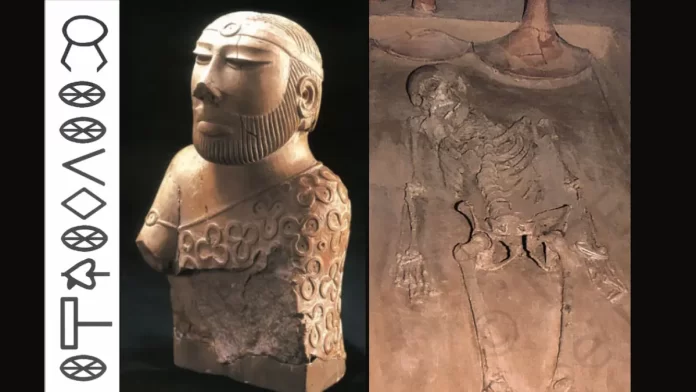The Indus Valley Civilization, also known as the Harappan Civilization, remains one of the most fascinating and enigmatic ancient civilizations in history.
Flourishing around 2600-1900 BCE, this advanced society thrived in the fertile plains of the Indus River, encompassing parts of present-day India and Pakistan.
In this article, we will dive into the mysteries of the Indus Valley Civilization, exploring some startling facts that will pique your curiosity and understanding of a bygone era.
Urban Planning Marvels
The Indus Valley Civilization boasted remarkable urban planning, evident in its meticulously designed cities.
Cities like Mohenjo-daro and Harappa showcased an advanced sewage system, with houses connected to a well-laid network of underground drains.
The presence of public baths and granaries hints at a society that valued hygiene, public welfare, and efficient resource management.
Older than Vedic Civilization
The Indus Valley Civilization predates the Vedic Civilization, making it older in terms of historical chronology.
The Indus Valley Civilization flourished from approximately 2500 BCE to 1900 BCE, while the Vedic Civilization emerged later, around 1500 BCE.
The advanced urban planning, intricate artwork, and complex trade networks of the Indus Valley Civilization showcase a highly developed society that thrived before the rise of the Vedic Civilization.
Interestingly, IVC was a sedentary civilization but Rigvedic people were largely nomadic.
They Buried their Dead
Archaeological excavations have revealed numerous burial sites throughout the Indus Valley region, where bodies were interred with care and reverence.
This burial practice signifies the cultural diversity and unique customs of the Indus Valley people, offering a glimpse into their beliefs and rituals surrounding death and the afterlife.
Contrary to this, cremation became the norm in the Vedic Civilization that followed.
They wrote from Right to Left
One of the most intriguing aspects of the Indus Valley Civilization is its script.
Despite numerous archaeological discoveries, the written script of this ancient civilization remains undeciphered.
Scholars have encountered over 400 distinct symbols on seals and pottery, indicating a written language that has yet to be fully understood.
Though the script remains undeciphered, it is apparent that it was written from right to left like Hebrew and Arabic as some seals show a wider spacing on the right and cramping on the left, as if the engraver began working from the right and then ran out of space.
Also, so far no Indo-Aryan inscriptions of Vedic times have been found in India. But Brahmi and Devanagari are written from left to right.
Had Extensive Trade Links with Middle East
The Indus Valley Civilization has extensive trade links with the Middle East.
In this context, it is worth noting that Mesopotamian texts mention contact with regions named Dilmun (probably the island of Bahrain), Magan and Meluhha, possibly the Harappan region.
Mesopotamian texts refer to Meluhha as a land of seafarers. Besides, we find depictions of ships and boats on seals.
Recent archaeological finds suggest that copper was also probably brought from Oman, on the south- eastern tip of the Arabian peninsula.
Chemical analyses have shown that both the Omani copper and Harappan artefacts have traces of nickel, suggesting a common origin.
This trade facilitated the exchange of goods, ideas, and cultural influences, contributing to the economic and cultural vibrancy of the Indus Valley Civilization.
Palaces and Kings
If we look for a centre of power or for depictions of people in power, archaeological records provide no immediate answers.
A large building found at Mohenjodaro was labelled as a palace by archaeologists but no spectacular finds were associated with it.
A stone statue was labelled and continues to be known as the “priest-king”.
This is because archaeologists were familiar with Mesopotamian history and its “priest-kings” and have found parallels in the Indus region.
Contradictions with Vedic Civilization
Aryan invasion of Indus Valley Civilization is a hotly debated issue. Hindu Brahmanical groups not only fiercely deny the Aryan invasion theory but also attempt to Brahmanize it by pointing out some continuities and interlinkages. However, historical records suggest otherwise.
For instance, an allegedly divine figure called “Pashupati” on Harappan seals is often compared with Rigvedic Rudra and Puranic Shiva.
However, unlike Shiva, Rudra in the Rigveda is neither depicted as Pashupati (lord of animals in general and cattle in particular), nor as a yogi. In other words, this depiction does not match the description of Rudra in the Rigveda.
With respect to Aryan Invasion, Historians have tried to correlate archeological evidence of massacres and urban destructions with Rigvedic texts.
The Rigveda mentions Pur meaning Fort, and Indra, the Aryan war-God is called Purandar which means the destroyer of forts.
According to acclaimed historian RS Sharma, some other notable differences between Harappa and Vedic Period include-
- Planned towns, crafts, commerce, and large structures built of burnt bricks mark the mature Harappan phase. The Rig Veda does not feature these.
- The early Vedic people lived on cattle rearing supplemented by agriculture, and did not use bricks.
- Also, the Harappan and Vedic people were not aware of exactly the same plants and animals.
- The Rig Veda mentions only barley, but the Harappan knew about wheat, sesamum, and peas.
- The rhinoceros was known to the Harappans but unknown to the early Vedic people. The same is true of the tiger.
- The Vedic chiefs were horse-centred, which is why this animal is mentioned 215 times in the Rig Veda, but the horse was hardly known to the urban Harappan.
- The Harappan terracottas represent the elephant, but unlike the horse it is not important in the earliest Veda.
- The Harappan writing, called the Indus script, has not been deciphered so far, but no Indo-Aryan inscriptions of Vedic times have been found in India.
Sources
- NCERT
- RS Sharma Ancient India
- Tamil Nadu State Books
